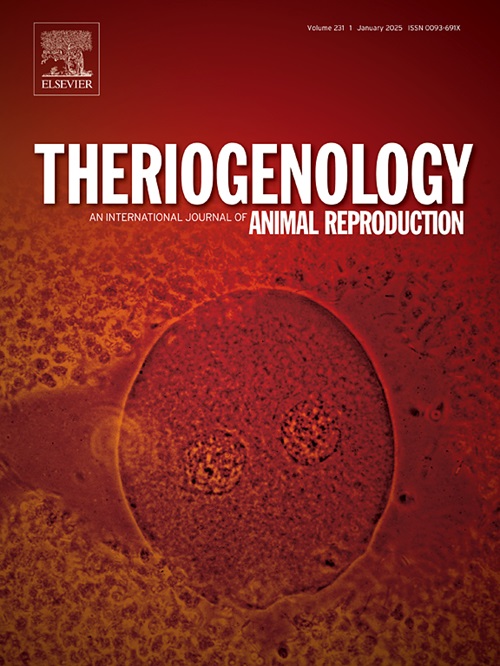马的植入前基因检测:对胚胎进行活检,以确定性别、毛色和疾病等位基因
IF 2.4
2区 农林科学
Q3 REPRODUCTIVE BIOLOGY
引用次数: 0
摘要
在马生殖中引入取卵、胞浆内单精子注射(ICSI)和体外胚胎生产具有显著的优势,包括克服不孕症、高囊胚产量、胚胎冷冻保存和通过使用口吸器收集胚胎生长过程中自然挤出的少量细胞进行着床前基因检测(PGT)。PGT能够在胚胎移植前进行胚胎选择,对于偏爱特定后代性别、毛色和检测遗传疾病的品种尤其有用。在这里,我们首次大规模验证了一种对马icsi来源的囊胚进行无创活检的方法,证实了其安全性和可靠性,并保留了胚胎的完整性。活检细胞使PGT成功用于性别确定、Tobiano白色斑点和临床DNA筛查疾病,如温血脆弱马驹综合征1型(WFFST1)和糖原分支酶缺乏症(GBED),使用基于pcr的分析,经Sanger测序验证。结果显示,746个ICSI囊胚的性别鉴定成功率为92.76%,平均雄性为56.21%,雌性为43.79%,品种间无显著差异。从杂合或纯合马的胚胎中分析的22份活组织检查中,超过90.91%鉴定出Tobiano基因型。此外,来自WFFST1携带种马的19个胚胎中有17个被成功诊断,其中29.5%被鉴定为杂合子。最后,从一只GBED载体种中鉴定出19个胚胎,其中21.05%为杂合子。本研究证明了OPU-ICSI胚胎的非侵入性PGT作为胚胎育种计划的工具的可靠性,控制遗传疾病的发病率,并为马辅助生殖的未来发展做出贡献。本文章由计算机程序翻译,如有差异,请以英文原文为准。
Preimplantation genetic testing in horses: biopsy of Piezo-ICSI embryos for sex, coat color, and disease alleles
The introduction of ovum pick-up, Intracytoplasmic Sperm Injection (ICSI) and in vitro embryo production in equine reproduction offers significant advantages, including overcoming infertility, high blastocyst yields, embryo cryopreservation, and preimplantation genetic testing (PGT) by collecting few cells extruded spontaneously during embryo growth using a mouth pipette. PGT enables embryo selection before transfer and is particularly useful in breeds with a preference for specific offspring genders, coat color, and detecting genetic diseases. Here, we present the first large-scale validation of a non-invasive biopsy method for equine ICSI-derived blastocysts, confirming its safety and reliability, preserving embryo integrity. Biopsied cells enabled successful PGT for sex determination, Tobiano white spotting and clinical DNA screening for disorders such as Warmblood Fragile Foal Syndrome Type 1 (WFFST1) and Glycogen Branching Enzyme Deficiency (GBED), using PCR-based assays validated by Sanger sequencing. Our results showed a 92.76 % success rate in sex determination among 746 ICSI blastocysts biopsied, with an overall mean of 56.21 % male and 43.79 % female, and no significant differences among breeds. Tobiano genotypes were identified in over 90.91 % of 22 biopsies analyzed from embryos of heterozygous or homozygous horses. Additionally, 17 of 19 embryos from a WFFST1 carrier stallion were successfully diagnosed, with 29.5 % identified as heterozygous. Finally, 19 of 20 embryos from a GBED carrier stallion were identified, with 21.05 % confirmed as heterozygous. This study demonstrates the reliability of non-invasive PGT of OPU-ICSI embryos as a tool for informed embryo breeding programs, controlling genetic diseases incidence, and contributing to future advancements in equine assisted reproduction.
求助全文
通过发布文献求助,成功后即可免费获取论文全文。
去求助
来源期刊

Theriogenology
农林科学-生殖生物学
CiteScore
5.50
自引率
14.30%
发文量
387
审稿时长
72 days
期刊介绍:
Theriogenology provides an international forum for researchers, clinicians, and industry professionals in animal reproductive biology. This acclaimed journal publishes articles on a wide range of topics in reproductive and developmental biology, of domestic mammal, avian, and aquatic species as well as wild species which are the object of veterinary care in research or conservation programs.
 求助内容:
求助内容: 应助结果提醒方式:
应助结果提醒方式:


